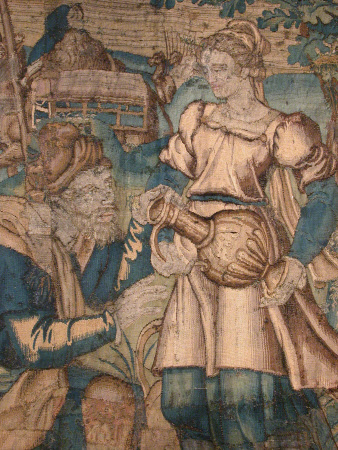Rebecca and Eliezer
Flemish
Category
Tapestries
Date
1560 - 1580
Materials
Tapestry, wool and silk, 4½-5½ warps per cm
Measurements
1620 x 1450 mm
Order this imageCollection
Packwood House, Warwickshire
NT 557882
Caption
This tapestry is woven from wool and silk and was made Oudenaarde in Belgium, a centre for tapestry making in the 16th century. This is one of the tapestries that Ash bought from Baddesley Clinton in the 1930s, and was found in a box there.
Summary
Tapestry, wool and silk, 4½-5½ warps per cm, Rebecca and Eliezer, Flemish, probably Oudenaarde, c. 1560-1580. A square tapestry showing the meeting of Rebecca and Eliezer at the well. On the left Eliezer, wearing a blue tunic and a yellow cloak and hat, kneels down on one knee to drink from a large water jug offered by Rebecca, who stands on the right wearing a pale mantle over a long blue dress. In the background Eliezer is seen again leading a camel laden with chests full of gifts, and more camels follow in the distance. A large oak tree fills the right hand side on the panel. The tapestry is relatively small in size and has no borders, and it almost certainly formed part of a larger piece.
Full description
The meeting of Rebecca and Eliezer occurs in chapter 24 of the book of Genesis. The aged Abraham, feeling his death approaching, sent his trusted servant Eliezer back to his home land to find a wife for his son Isaac, with gifts of camels and other goods. As Eliezer approached the city of Nahor he reached a well, where he prayed to the Lord that the first damsel who offered him water to drink would be the appointed wife of Isaac. Before he had finished speaking Eliezer saw Rebecca, and ran to meet her and ask her for water. Rebecca let Eliezer drink from her pitcher, and then brought water for the camels to drink as well. Eliezer discovered that she was the daughter of Nahor, Abraham’s brother, which confirmed to him that she was the ordained wife of Isaac. The composition of the tapestry is very similar, but in reverse, to a tapestry in the Rijksmuseum, one of a set of four depicting the ‘Story of Rebecca and Eliezer’ woven at an unidentified Brussels workshop (Hartkamp-Jonxis and Smit 2004, cat. no. 31, pp. 104-108). However the Packwood tapestry was probably woven at Oudenaarde, not Brussels as it bears strong similarities to a number of Oudenaarde tapestries of the second half of the sixteenth century. Examples include two tapestries from a ‘History of Moses’, in the collection of Zaragoza University, where a number of elements in the costume and landscape, and details such as the pitchers held by the women, are directly comparable (de Meuter 1999, pp. 151-152), and a tapestry with an identical border showing ‘David rebuked by Nathan’, which includes a group of distant camels very similar to those in the Packwood ‘Rebecca and Eliezer’ (de Meûter 1999, p. 151). As Ingrid de Meûter has shown large numbers of tapestries were exported from Oudenaarde to Great Britain during the sixteenth and seventeenth centuries, although in the absence of makers’ marks and provenance information their origin is often forgotten (de Meûter 1998). This is one of a group of tapestries which Graham Baron Ash bought from Edward Ferrers at Baddesley Clinton. In a scrapbook compiled by Ash in the 1930s he notes that it was found in a box at Baddesley, along with the table carpet in the Inner Hall (no. 557853). Its early provenance is unknown but it has clearly been the subject of extensive restoration work, probably during the nineteenth century. Large patches from other tapestries (or other parts of the same tapestry) have been inserted, especially in the lower areas of the panel, and disguised by extensive embroidered stitching that continues the outlines of the main design over the added patches. This is especially evident in Rebecca’s skirt, which on closer inspection contains a number of leaves, with the pleats in the cloth applied with brown wool stitching. The area above Eliezer’s head is also very confused and the background scene showing the the camels, although clearly part of the same tapestry, appears to have been detached and re-joined. (Helen Wyld, 2009)
Provenance
Ferrers Collection, Baddesley Clinton; bought by Graham Baron Ash during the 1930s; given by him to the National Trust in 1941
Credit line
Packwood House, The Graham Baron Ash Collection (The National Trust)
Makers and roles
Flemish, workshop possibly Oudenaarde, workshop
References
Packwood House 1931-38: Graham Baron Ash's Scrapbook c. 1931-1938 (557381) , Photograph with handwritten note: "A tapestry panel of Eleizer & Rebecca found in a box & bought from Baddesley Clinton XVI cent" De Meûter, 1998: Ingrid de Meûter, ‘Flemish Tapestries of the 16th and 17th Centuries in Great Britain and their Connection with Oudenaarde’, Bulletin de liaison du Centre International d’Étude des Textiles Anciens [CIETA], 75 (1998), pp. 97-109 de Meûter et al., 1999: Ingrid de Meûter, Martine Vanwelden et al., Tapisseries d'Audenarde du XVle au XVllle Siècle, Tielt 1999, pp. 151-152 Hartkamp-Jonxis and Smit, 2004: Ebeltje Hartkamp-Jonxis and Hille Smit, European Tapestries in the Rijksmuseum, Amsterdam 2004

